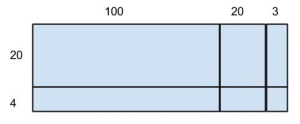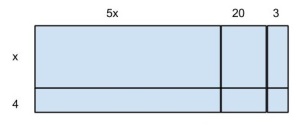Last year, when assisting a grade six student with a multi-digit multiplication exercise, I realized just how confusing the typical multiplication algorithm is. In this specific instance, the student was having a hard time remembering when she should multiply digits and when to add them. Because she had learned the algorithm by rote, the steps had no meaning and were easily confused. This is well-explained in a video by Raj Shah that I came across recently via social media.
Thankfully, just before my student encountered that particular difficulty, I had seen an alternative method in which you draw a rectangle to represent the problem, just like in Shah’s video (starting at the 4:53 mark). So, 123 x 24 becomes:
Student can then see (literally), that they need to multiply first and then add the products together to get the overall product. This is the same process as in the vertical multiplication algorithm
Once I saw this method, I wished all my students had learned to multiply this way. It connects better with how younger students tend to think of single digit multiplication when they were first introduced to it (check out this post from Math with Bad Drawings for an example), and it supports what students will learn later when they cover the distributive property in algebra. Again, students are able to see how to expand (x+4)*(5x+23).
Eventually, students will probably use the FOIL acronym as a short cut, but at least they will know where it came from.
While teaching students why certain algorithms work is an investment of time, that deeper understanding lays the foundation for more sophisticated math and pays dividends later on. Doesn’t that make the investment worthwhile?


Leave a comment